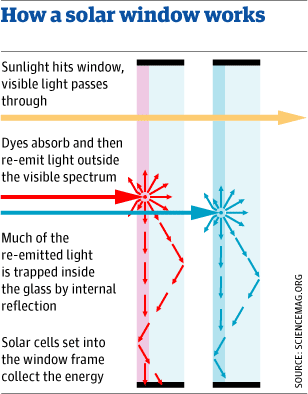Dyes turn windows into powerful solar panels
Windows could be used as powerful solar panels thanks to a clever new technology that concentrates the sun's rays. The technique uses transparent dyes to capture, concentrate and redirect light along the surface of the glass to photovoltaic (PV) cells in the frame, which convert the light into electricity. The breakthrough means that there is a tenfold increase in power output compared to use of the PV cell alone.
The team, from the Massachusetts Institute of Technology (MIT), claims the technology could slash the cost of generating electricity from sunlight, making it more competitive with standard grid power. This is because the expensive PV cells only need to be installed at the sides of the panels, rather than across the whole surface.
Sunlight is concentrated in existing solar power devices using large, mobile mirrors that track the sun as it moves across the sky. But these can be expensive to deploy and maintain. In the MIT device, called an "organic solar concentrator" and described in the latest issue of Science, the researchers painted a mixture of organic dyes onto the surface of a pane of glass. The dyes trap different wavelengths of sunlight and then guide the energy along the glass towards the PV cells at the edges.
"The point of all this is to get away with using far fewer solar cells," said Marc Baldo, an electrical engineer at MIT. "The concentrator collects light over its whole front surface, but the solar cells need only cover the area of the edges."
As the edges of a glass panel can often be 100 times smaller in area than the surface itself, he added, solar panels would need 100 times fewer PV cells to collect the same energy. "So we can save money. Since industry can't produce enough solar cells to satisfy demand, this might also be a good way to stretch production."
As well as windows, the technique can be applied to standard solar panels on roofs and walls to improve their efficiency. "We think the technology should cost less than $1 per watt [to build]", said Baldo.
The MIT device is relatively simple to manufacture and researchers claim it could be commercially available within three years.
Martyn Berry, senior research and development engineer at solar-energy company Solarcentury, said the biggest challenge for PV technology was to make it competitive with standard electricity."The notion that we could see a tenfold reduction on the cost of PV technologies through the use of organic solar concentrators is certainly exciting. Current concentrator technology is not generally suitable for the mass market."
Baldo said any transparent material could be used as the concentrator. "In the window application you'd probably design the window for 10% transmission [of light]. The remaining 90% is captured and used to generate electricity."
A more immediate use of the concentrator technology would be to coat the conventional solar panels used on the roofs of buildings, to boost their light collecting ability.
"We saw approximately 30% higher performance in the combined system compared to a stand alone solar cell," said Baldo. "We think that ultimately this approach will allow us to nearly double the performance of existing solar cells for minimal added cost."
A similar method to concentrate solar energy was developed in the 1970s. But the system, which painted dyes onto plastic surfaces, was abandoned because it could not collect enough of the sunlight and much of the retransmitted light was absorbed and lost as it travelled through the material to the PV cells.
To make their breakthrough, Baldo's team used advances originally developed to improve lasers and organic light-emitting diodes. By using the newer dyes in carefully chosen ratios and applying it only to the surface of a glass panel, the scientists were able to more accurately control how much light was absorbed and transported across it. "We made it so the light can travel a much longer distance," said Jonathan Mapel of MIT, who also worked on the solar concentrator.
Greenpeace's chief scientist, Doug Parr, said: "Innovations like this show renewable technologies can take a quantum leap forward if given proper financial support from governments. Rather than betting the farm on outdated nuclear technology and hoping that coal will one day be 'clean', Gordon Brown should be creating green jobs and pushing at the real technological frontier of the 21st century - renewables."
























1 comment:
Here's how to cut your electric bill up to 75%:
Want to know how to easily produce all of the green energy you could ever want right at home?
And you will be able to make your home totally immune from power outages, blackouts, and energy grid outages…
so even if everyone else in your area (or even the whole country) loses power - you won’t.
VISIT THIS SITE: DIY HOME ENERGY
Post a Comment